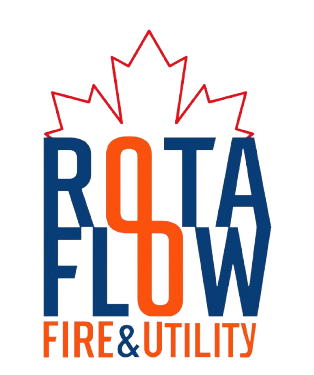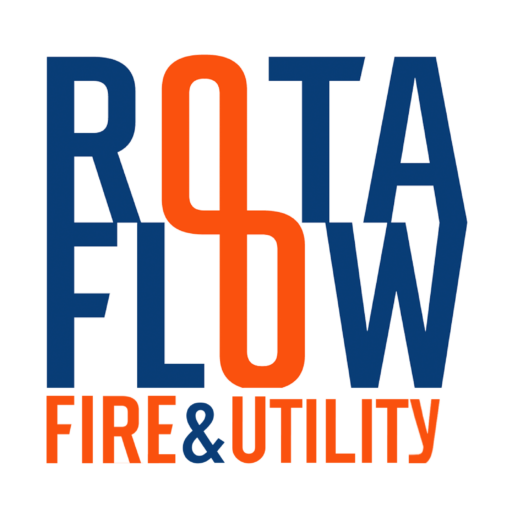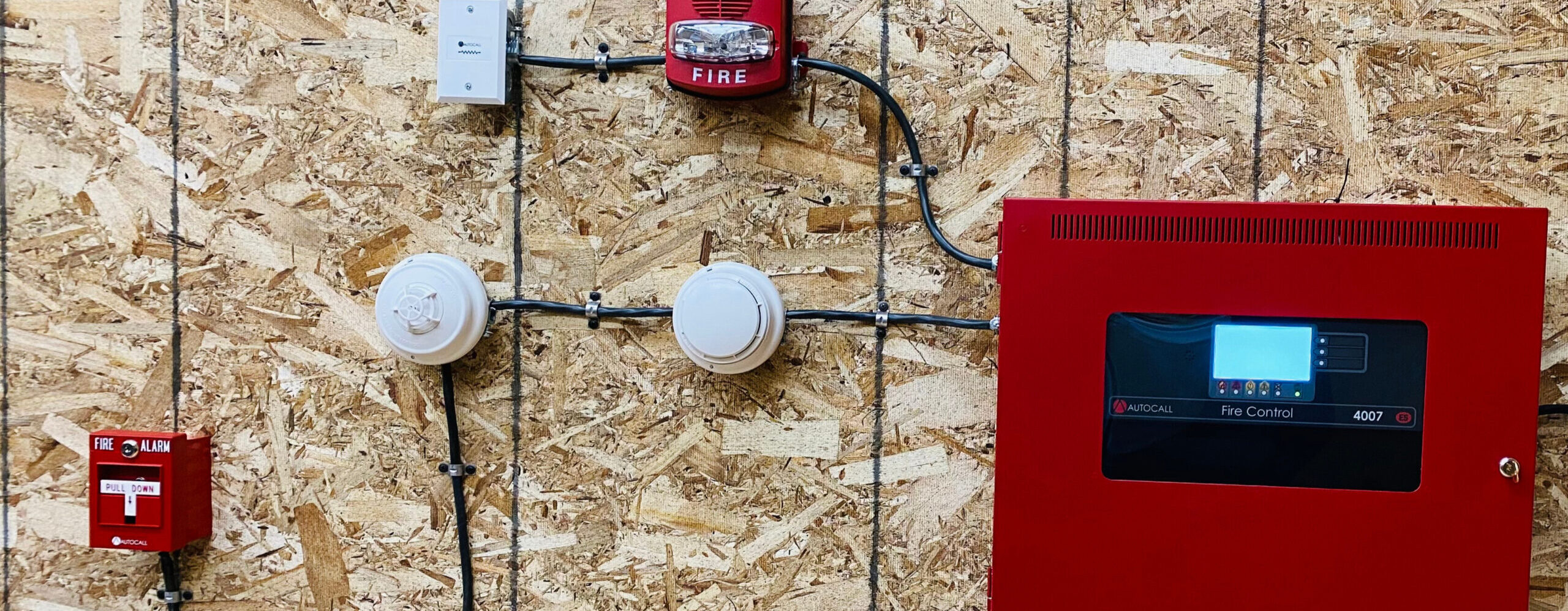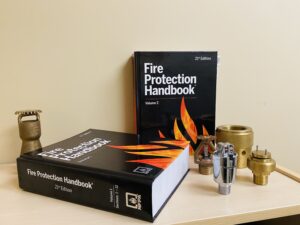INTRODUCTION: Automatic sprinkler systems and fire alarms have long been used together to protect building inhabitants and improve fire prevention. A fire alarm system is defined by the International Fire Code (IFC) as a system or portion of a combination system consisting of components and circuits arranged to monitor and annunciate the status of fire alarm or supervisory signal-initiating devices and to initiate the appropriate response to the signals. Alarm starting devices and supervisory devices are among the parts that a fire alarm system keeps an eye on. If a monitored alarm device detects a probable fire condition, the fire alarm control panel (FACP) will detect a signal and initiate the proper reaction. If the building has an occupant alerting system, the horn/strobes or voice evacuation system will activate.
Fire alarm systems with dedicated functionalities can handle emergency tasks such as turning on smoke control systems, reaction or deluge valves, and recalling elevators. An alert signal is sent to a central station, while a difficulty signal indicates a problem with the fire alarm system itself. Not all FACPs are obliged to alert a central station, but some do. The IFC specifies the locations where sprinkler systems are necessary in Section 903.2 and the locations where fire alarm systems are needed in Section 907.2. NFPA 72 distinguishes between a fire alarm panel installed to monitor a general function and a full fire alarm system comprised of horns/strobes, detection, and manual pull stations.
When a fire alarm system with occupant notification is mandated by IBC Section 907, one or more of the following must occur before the fire alarm notification appliances (horns, speakers, strobes) will operate: automatic devices for sprinkler system waterflow, automatic fire detectors, manual pull stations, and automatic fire-extinguishing systems. Section 7.7 of the NFPA 13 2022 edition was changed to divide the requirements based on whether a waterflow alarm device is mechanical or electrical. The 5-minute threshold set forth by NFPA 13 is meant to account for variations in water flow in buildings with mechanical alarms but no fire alarm system. Section 903.4 of the IBC mandates that waterflow be under the supervision of a listed fire alarm control unit. Additionally, the waterflow alarm device has an additional ten seconds after the initial 90 seconds to activate the building’s notification. Hospitals present particular difficulties for sprinkler and fire alarm systems. The IBC mandates that floors be segregated into two smoke compartments separated by smoke barriers, and the NFPA 99 Healthcare institutions Code requires sprinkler zones to match with smoke compartment borders. Elevator inspectors, fire sprinkler installers, and fire alarm technicians have expressed concern about the fire protection regulations for elevator shafts. NFPA 13 stipulates that a sidewall sprinkler in the lift hoist way must be installed no higher than 2 feet above the pit’s floor. For traction type elevators, sprinkler protection is not necessary.
Fire alarm detection must be offered if Phase I emergency recall is necessary. Heat detectors must have a lower temperature rating and higher sensitivity than sprinklers when they are used to shut off the lift power before sprinkler operation. Smoke detectors are not allowed to be used to turn on sprinklers or cut off the main line power supply to the lift equipment.
Jelly with peanut butter. Pepper and salt. bacon with eggs. The NFPA 13 and NFPA 72…? Despite the fact that this pairing may appear odd, automatic sprinkler systems and fire alarms have long worked in concert to safeguard building inhabitants and improve fire prevention generally. It only makes sense that sprinklers and alarms are frequently referenced in the same phrase when discussing fire safety because many modern structures are mandated by model codes to have both.
FIRE ALARM SYSTEM BASICS
A fire alarm system is defined by the International Fire Code (IFC) as “A system or portion of a combination system consisting of components and circuits arranged to monitor and annunciate the status of fire alarm or supervisory signal-initiating devices and to initiate the appropriate response to the signals.” Alarm starting devices and supervisory devices are among the parts that a fire alarm system keeps an eye on. Flow switches, smoke detectors, heat detectors, and other fire-detective components are examples of alarm-initiating devices. Devices that initiate supervisory signals are made to keep an eye on the state of systems or pieces of equipment that aren’t directly connected to the fire alarm system. Sprinkler systems, smoke detection equipment, backup generators, fire pumps, and other similar devices are examples of these.
The fire alarm control panel (FACP) will recognise a signal if a monitored alarm equipment identifies a potential fire condition. The FACP will subsequently start the proper response (which is defined in Section 907 of the IFC based on the kind of protected occupancy). The horn/strobes or voice evacuation system will go on if the building has an occupant alerting system. Activating smoke control systems, preaction or deluge valves, or recalling elevators are just a few examples of emergency actions that can be started. Finally, a central station will often receive an alarm signal. Prior to alerting the building owner or designee, NFPA 72 mandates that the central station promptly notify the relevant fire department of an alarm activation.
An alert state is not indicated when a supervisory signal starting device activates. However, it does point up a problem that the building owner or designee should address right away. An activated tamper switch could mean that the water supply for the sprinkler system has been cut off. As a result, the FACP will sound an alert and the central station will get a supervisory signal. The building owner or designee will be called following a supervisory signal and is required to reply in order to look into and address the issue. Most of the time, a supervisory signal won’t result in a call to the fire department.
A third sort of signal, known as a difficulty signal, may be produced in addition to alarm and supervisory signals. A trouble signal indicates a problem with the fire alarm system itself, as opposed to supervisory signals, which indicate a problem with a component or system the fire alarm system is monitoring. Low battery, no AC power, open circuits, or a lack of communication are examples of problematic conditions. These are often addressed to the building owner rather than the fire department, similar to supervisory signals.
A signal to a central station is not necessary from all FACPs. Fire alarm systems with dedicated functionalities are made to handle particular emergency tasks. An lift shaft’s detecting devices, for instance, may be monitored by a special function system to start a recall. A dedicated function system could additionally have a preaction control panel. (Even if the preaction panel doesn’t send a signal to a central station, the building’s FACP monitors it and sends a signal.)
One common misperception across the nation is that although the code (IFC Section 903.4) mandates that a sprinkler system be monitored by a FACP, horns and strobes must also be used to alert building occupants. That is untrue. The IFC specifies the locations where sprinkler systems are necessary in Section 903.2. The locations where fire alarm systems are needed are listed in Section 907.2. If 907.2 does not mention occupant notification expressly, none is necessary.
MODEL CODES, SPRINKLERS AND FIRE ALARMS
The model codes mandate the installation of fire sprinklers in buildings and the supervision of the sprinkler system’s water flow by a designated fire alarm control unit. This system has a dedicated function, according to NFPA 72. To distinguish between a fire alarm panel installed to monitor a general function (such as sprinkler waterflow, duct detectors, or lift control functions) and a full fire alarm system comprised of horns/strobes, detection, and manual pull stations, this term was added to the 2007 edition of NFPA 72. To make it clear that there are instances in which a fire alarm system with horns, strobes, detection, and pull stations is not necessary in a building, the phrase specialised function fire alarm system was added to NFPA 72. The International Building Code’s Section 907 is intended to specify when a fire alarm system is necessary and what it must do, including activating a general evacuation signal, starting an emergency voice alarm communication system, detecting fire in particular areas, etc.
FIRE SPRINKLERS and OCCUPANT NOTIFICATION
When a fire alarm system with occupant notification is mandated by International Building Code (IBC) Section 907, one or more of the following must occur before the fire alarm notification appliances (horns, speakers, strobes, etc.) activate:
- Gadgets for automatic sprinkler system waterflow
- Automated fire alarms
- stations with manual pulls
- Systems for extinguishing fires automatically (IBC Section 904)
The standards for waterflow alarm devices were divided in Section 7.7 of the NFPA 13 2022 edition according to whether the device is mechanical or electronic. For many years, NFPA 13 has mandated that, within five minutes of the start of water flow from a single sprinkler, the premises must be audibly alerted. When comparing the requirement for a waterflow alarm to activate within 90 seconds in NFPA 25 and NFPA 72, this requirement has led to some confusion. The 5-minute threshold set forth by NFPA 13 is meant to account for variations in water flow in buildings with mechanical alarms but no fire alarm system. However, keep in mind that Section 903.4 of the IBC mandates that waterflow be under the supervision of a listed fire alarm control unit. According to NFPA 72, a fire alarm control unit built just to monitor sprinkler waterflow is referred to as a dedicated function fire alarm system. A structure constructed in accordance with the IBC or IFC is obliged to have a listed fire alarm control unit for monitoring waterflow (dedicated function fire alarm system), as per NFPA 72’s definition of a dedicated function fire alarm as a “fire alarm system”. According to NFPA 72, the waterflow alarm equipment has a total of 100 seconds, or an additional ten seconds, after the initial 90 seconds, to trigger the building’s notification (horn/strobes). For structures having fire alarm systems, including specialised function fire alarm systems, and for any system using electrically operated local alarm bells, NFPA 13 did clarify this requirement in Section 7.7.2 of the 2022 edition of NFPA 13.
FIRE SPRINKLER CONTROL VALVE SUPERVISION
There has been some misunderstanding between the requirements in NFPA 13 Section 16.9.3.3.1 to chain and lock control valves and the IBC requirement, Section 903.4, to electrically supervise valves and other components. It’s critical to understand that Sections 102.4.1 and 102.4.2 of the IBC specifically handle this issue. When there is a dispute between the code and a referenced standard, the code shall control, according to Section 102.4.1. When a cited code or standard includes subject matter that is covered by this code, Section 102.4.2 further explains that even when there is no apparent conflict, the provisions of this code take precedence over the referenced standard. In other words, the IBC need for a listed fire alarm control unit takes precedence over the four requirements mentioned in NFPA 13, Section 16.9.3.3.1, since the IBC addresses supervision in Section 903.4.
SPECIAL RULES FOR HOSPITALS
For designers of sprinkler and fire alarm systems, hospitals present difficulties. The IBC mandates that floors be segregated into at least two smoke compartments separated by smoke barriers because the majority of patients in these facilities are unable to self-evacuate. The hospital staff will relocate patients from the smoke compartment that is on fire to a neighboring compartment where they will be safe in case of a fire. Each smoke compartment is typically limited to 22,500 square feet per IBC Section 407.5.1. Unless another option is provided in the facility fire plan, NFPA 99 Healthcare institutions Code, Section 16.9.1.3, 2021 edition, mandates that sprinkler zones match with smoke compartment borders in all institutions where patients are not expected to automatically evacuate. Similar specifications are provided for fire alarm system zones in Section 16.7.4.3.1. The purpose of these provisions is to guarantee that crucial life safety features stay operational in areas where patients are present if they are destroyed by fire or shut off within a compartment after the fire. This sprinkler provision has the effect of reducing sprinkler zones within healthcare institutions much more than the NFPA 13-allowed 52,000 square feet space for light hazard occupancy.
ELEVATOR, SPRINKLER AND FIRE ALARM REQUIREMENTS
Elevator inspectors, fire sprinkler installers, and fire alarm technicians have all expressed concern about the fire protection regulations for elevator shafts. Confusion and uncertainty about when sprinklers and detectors are necessary in the lift shaft have resulted from the need to balance regulations between ASME A17.1, the International Building Code, NFPA 13, and NFPA 72.
When hydraulic fluids are present in the area, NFPA 13 stipulates that a sidewall sprinkler in the lift hoistway be installed no higher than 2 feet above the pit’s floor. There is a suggestion that all lift hoistways without sprinklers be permitted in the NFPA 13 2025 edition. The NFPA standards development process is still awaiting final approval of that plan, nevertheless. For traction type elevators, when the requirements listed in Section 9.3.6.3 are satisfied, sprinkler protection is not necessary in the hoistway.
Phase I emergency recall is required by ASME A17.1 for almost all elevators. When sprinklers are put in the lift hoist way, fire alarm detection must be offered if Phase I recall is necessary. Since hydraulic elevators are required by NFPA 13 to have sprinkler protection at the bottom of the hoist way, a fire alarm detection device must also be installed near to the sprinkler. The fire alarm initiating device must be placed at the top of the hoist way in cases when sprinklers are installed above the lowest level of recall.
The fire alarm initiating device must be positioned within 24 inches of each sprinkler where they are located in the pit. Heat detectors must have a lower temperature rating and a higher sensitivity than sprinklers when they are used to shut off the lift power before sprinkler operation. Smoke detectors are not allowed to be used to (1) turn on sprinklers in the hoist way (pre-action system) or (2) cut off the main line power supply to the lift equipment, according to ASME A17.1.
John Swanson, the NFSA’s Code and Standards Specialist, wrote this edition of TechNotes.



